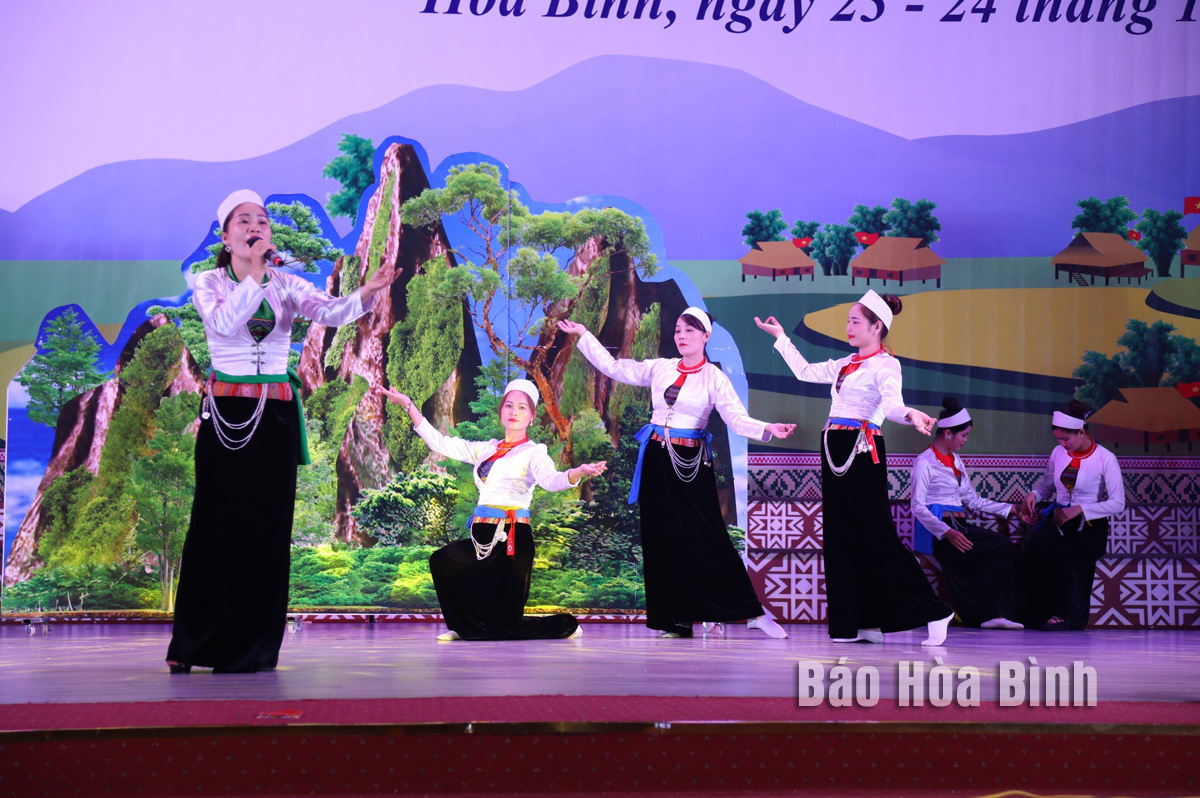
The recent 2023 folk art festival of ethnic minority groups in Hoa Binh province featured outstanding performance of songs and dances as well as reenactments of outstanding festivals, leaving good impression on folk art lovers.
An impressive performance of Lac Son district at the festival.
During the two-day festival, nearly 300 artisans and artists from 10 district-level localities across Hoa Binh showed their outstanding singing and dancing performances and reenacted some outstanding arts and festivals of their ethnic groups and localities. The event aimed to help preserve and bring into play cultural heritage values of local ethnic minorities.
Luu Huy Linh, Deputy Director of the provincial Department of Culture, Sports and Tourism and head of the festival organising committee, said that on the occasion of the Vietnam Cultural Heritage Day (November 23), the department stepped up the organisation of folk art festivals of ethnic minority groups at all levels.
As many as 80 of the 151 communal-level localities organised festivals with more than 16,000 performers, attracting over 40,000 spectators. Ten district-level festivals were also held with the participation of 10 communes, wards, and townships, 3,400 performers, and over 10,000 spectators. The provincial-level event featured performances by people of all age groups, including many holding the Meritorious Artist and People’s Artist titles.
In particular, part of traditional cultural rituals, festivals, and ceremonies were also reenacted, helping spectators gain a better understanding of cultural and religious identities of ethnic groups.
Linh went on to say that those festivals provided not only playgrounds for folk art groups but also occasions for local artisans and artists to show their skills, share experience, and improve their performing capacity. They helped enrich people’s spiritual life, maintain cultural identities of ethnic groups, and develop cultural activities in the community, thereby gradually meeting the public’s cultural enjoyment demand.
As a land deeply intertwined with human history and Vietnam’s millennia-long journey of nation-building and defence, Hoa Binh is often revered for its epic tales and legends.
Residents of Hoa Binh boast a rich cultural identity, reflected in their unique language, traditional attire, customs, and folk melodies – described as "sweet as honey, clear as a mountain stream.”
Lac Son district’s Vu ban town held the 2025 Truong Kha temple festival on April 12–13 (the 15th–16th days of the third lunar month). Since its revival in 2019, the festival has been organised every three years, preserving valuable intangible heritage while meeting the community’s cultural and spiritual needs.
The clothing of women reflects the culture of the Muong, Thai, Tay, Dao, and Mong ethnic groups in the northern province of Hoa Binh.
Gongs hold a special place in the cultural and spiritual life of the Muong ethnic people in Hoa Binh province. More than musical instruments, they are an indispensable part of community rituals and collective memory, echoing through generations as a spiritual thread linking the past, present, and future.
Preserving and promoting the cultural values of the Muong ethnic group has become an urgent task in the current context, as many traditional values face the risk of fading away. This effort requires not only protecting the cultural identity but also eliminating outdated customs and developing a modern cultural lifestyle, contributing to sustainable values for the Muong community in Hoa Binh province.
The Muong ethnic culture, deeply rooted in Vietnam’s mountainous north, continues to be preserved and revitalised by dedicated individuals and communities determined to safeguard their ancestral identity.



